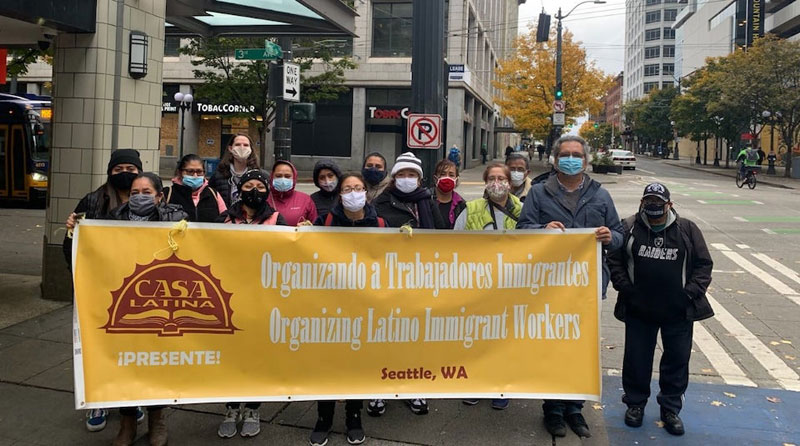

As Marcos Martinez, who directs Casa Latina in Seattle, recalls, just as there was a time when homelessness in the US was rare, once, finding day laborers on US street corners was also uncommon. That changed in the 1980s and early 1990s as economic dislocation in Mexico pushed many to immigrate to the United States. In 1994, the North American Free Trade Agreement (NAFTA) went into effect, which led many Mexican farmers to migrate northward, as they were often unable to compete with low-cost, mechanized US agriculture.
In Seattle, many migrants sought jobs in the city’s maritime industry when they arrived. But “while they were waiting to get those jobs, people were kind of on the street and trying to get hired as day labor,” Martinez explains. In response, community members “started meeting with these workers…to discuss what their needs might be and how the community might be able to provide support.” Seattle’s Casa Latina, formed in 1994, was the product of those conversations. Today, it is one of over 50 centers nationally that constitute the membership of the National Day Laborer Organizing Network, or NDLON. These centers are run according to popular education principles. Workers elect their own leaders, hold their own meetings, set their own wage levels, and establish reglamentos, or codes of conduct, to hold each other accountable.
These centers do not reach all day laborers; in fact, the centers still only reach a minority of those who rely on day labor to earn a living. But amid the pandemic, these centers have grown in importance. Begun as “worker centers” where laborers could come together to set wages, enforce basic labor rights, and take English as a Second Language (ESL) classes, they have evolved into multifaceted community hubs.
During the pandemic, day laborer centers have had to transform their operations. This includes everything from developing remote job dispatch operations to instituting a wide range of financial and in-kind supports. Not every day laborer is undocumented, but those who are have been denied access to federal benefits—including relief checks and unemployment insurance.
A recent New York State law makes clear just how costly this exclusion was. Passed in April 2021, the law, reports Daniel Parra for City Limits, creates an unprecedented $2.1 billion Excluded Workers’ Fund that will provide $3,200 in replacement payments for the relief checks not received to an estimated 199,000 New Yorkers, with another 92,000 expected to also receive additional unemployment payments. Based on population data from the Pew Research Center, it’s clear that similar coverage at the national level would cost over $30 billion. And even New York’s new law, Parra notes, may leave behind hundreds of thousands of undocumented workers.
Absent significant government support (other than New York’s law this spring), day laborer centers have had to raise funds to help workers pay rent and utility bills. Many also became de facto food pantries and raised funds to provide workers direct cash assistance. They also became COVID testing centers and are now often assisting with vaccine administration.
Julio Ornelas Dominguez, a day laborer in Santa Cruz, California, has been a member of the county day laborer center operated by the local nonprofit community action agency for more than a year and a half. He says the pandemic has been difficult, “but we have been able to move forward with the support of the workers’ center, honestly.”
At NPQ, we shared some stories about day laborers a year ago, as well as reporting on a national survey last summer. Here, we take a look both backward and forward—it is a story of nonprofit innovation, heartbreak, and hope for a better future.
The Pandemic Arrives
Luis Valentan himself was a day laborer for 10 years. Like many of the people in Seattle Martinez describes, Valentan immigrated to the United States in 1991. He is now a staff member at NDLON, where he serves as West Coast Regional Coordinator. Valentan outlines some of the challenges: “When we first learned about COVID, most of the information coming out was in English. It was hard to translate those words in a way our workers could understand.… It created a lot of confusion.”
Valentan adds that, “Obviously, there is no financial support. Even though they knew there was a pandemic, a virus, that was killing everyone,” day laborers had to work to pay rent and bills. “Otherwise, they would lose everything.”
At the same time, jobs dried up quickly. The drop was most severe for domestic workers, as few homeowners were willing to hire people to come inside their homes. Gloria Guzmán had worked as a housecleaner through the Santa Cruz center for four years. But amid the pandemic, even with an 18-month-old child, Guzmán and her family moved to Watsonville to work in the fields for seven months. “There wasn’t any work anywhere else,” she says.
Ornela Dominguez recalls that he had thought he might replace day laborer earnings by delivering food. But while delivering for one customer, he was told to drop the bag of food “on the floor, as if I were a zombie.” He did as demanded, even though he knew the health benefits of doing so were nil because he had already touched the items before when packing them. Rather than face demeaning comments, he opted to stop making deliveries and went “a month without work.”
Retooling Operations
Before the pandemic, day laborers had had a high level of in-person interaction among themselves and with the centers. With COVID-19, this had to change—and quickly. In Seattle, Martinez explains, “Normally, we would open at 6:30 am. By 7 am, we would have 50 or 60 workers in our dispatch center waiting for jobs. Of course, with COVID, you can’t do that. The people who run our worker center, they organized the workers into teams of maybe 10 or 12 people. Each team has a leader. They started having regular weekly meetings with the team leaders to keep everyone up to speed with what’s happening, how things are developing, and it was also a good way to stay in touch with everyone.”
Also critical in retooling was getting a handle on community needs. In Santa Cruz, Paola Fernandez, once a dayworker herself who now works as a dispatcher for the center, explains, “When everything began to shut down, we started a list of the resources that were available through the Community Action Program. That was the first step. Then we began to look for resources…such as distributing food every week. Then we began to look at the need for transportation. Many lacked the money for gas.”
Ultimately, one of the functions of the center became distributing cards for gas to workers who needed them, every Saturday from 10 am to 2 pm.
Sign up for our free newsletters
Subscribe to NPQ's newsletters to have our top stories delivered directly to your inbox.
By signing up, you agree to our privacy policy and terms of use, and to receive messages from NPQ and our partners.
Another major challenge was training workers and staff on how to communicate remotely. Nancy Torres, who is director of the Pasadena Community Job Center, notes that she had to do individualized trainings for workers on how to use their devices to communicate. “It was a little bit challenging. Many of the workers are not familiar with the technology. It takes up a lot of time and volunteer work,” she says.
From Emergency Chaos to Sustained Support
Maria Rodriguez-Castillo, who directs the day workers’ center program in Santa Cruz, observes that the first few months, from March to June especially, were marked by great uncertainty. “There were two or three months of chaos, I think. We were in a state of emergency. We were not prepared to offer virtual services.” Training day laborers to use services like Zoom, she explains, required a lot of one-on-one training, even as center staff also had to train themselves. Now, a year in, operations have reached a rhythm, even though times remain hard, with groups of 30 workers or more now carrying out their regular worker assembly meetings via Zoom, as well as enrolling in virtual ESL classes. “We are all more established virtually,” Rodriguez-Castillo notes.
Another part of the centers’ work has been to distribute money and support for basic needs. Backed by philanthropy through NDLON, there have been four rounds of cash distribution. At Santa Cruz, this worked out to $100 per person per round. The center also served as a hub for the distribution of one-time payments of $500 from the state of California. And there were other forms of assistance for gas, rent, utilities, and food.
Still, there is no doubt that resources were limited. Sometimes, day laborers triaged among themselves. Ornela Dominguez notes that, “With the cards, I don’t always ask for them. We are many.” For example, if he took a card the prior month, he wouldn’t take one the following month. “I dare to be honest,” he says.
Because many day laborers are undocumented, maintaining confidentiality in the distribution of aid is critical. Rodriguez-Castillo emphasizes that the center is “low barrier. We don’t ask for identification of anyone.” In Seattle, Martinez decided the best way to maintain confidentiality was to literally disburse cash. “There were days when I would go in there and walk out with $90,000 under my arm,” he says. “We would divide it up and put it into envelopes,” with families getting between $200 and $400 each.
Health and Solidarity
Another function of the centers was to help members avoid the virus, including helping distribute masks. Nonetheless, the economic necessity driving day laborers meant sheltering in place was not possible, and many of the workers did contract COVID. In Pasadena, Torres relates, “I was looking at my list of families that we have helped. I started asking how many had got infected by COVID. It was amazing: out of 134, 94 had gotten already COVID. These are low-income families. These are the people who were excluded. It is hard. A lot of them do not qualify under certain criteria to get the vaccine.”
In Seattle, Martinez says 15 percent of day laborers had contracted COVID and adds that this estimate was made a while ago. An up-to-date estimate would be higher. In Santa Cruz, both of the interviewed day laborers said they had contracted the virus. Ornelas Dominguez says that “I had COVID at the beginning of the year. It was a difficult three weeks.” Guzmán got COVID in March. For her part, Guzmán credits friends and family for seeing her through. “We are in a moment,” she observes, where “we each have to help each other out.”
Martinez emphasizes that this ethic of mutual aid is central to day laborer culture. The workers, he notes, “rely on each other. One thing the workers have done here at Casa Latina is create a mutual aid fund, a self-insurance pool, in which workers contribute a few dollars a week. If they are ever injured, they can draw at least few hundred dollars.… It’s not a huge amount, but it’s a fund the workers have put together.”
Toward a Future Vision
The pandemic may be subsiding, at least in the United States, but it has hardly ended. In Pasadena, for instance, Torres notes that, “We are still working partially virtually and partially in-person. In-person is for the staff, but members are not yet allowed to come to the center.” But planning for a post-pandemic future is under way.
Torres believes that some of the learnings of the pandemic year are likely to continue. For instance, ESL classes by Zoom will likely still take place to reach those who cannot attend in person. And she is heartened by the greater coordination among community agencies that has developed amid the pandemic.
The food pantry service is likely to continue too. One thing that the Pasadena center learned, Torres relates, is the importance of purchasing produce that day laborers are familiar with. In March, she notes, the center distributed 500 food baskets. “We do the distribution three times a month,” she adds.
In Santa Cruz, Rodriguez-Castillo looks forward to reopening. The day workers’ center, she notes, “is a community. We all miss it so much.… This day worker community is very important, especially for the day worker whose family is not here. The opportunity for leadership development is also very important.” Fernandez adds that the reopening can be an opportunity to “strengthen the day laborer community.”
In Seattle, Casa Latina is gearing up to open a second location in South King County that is closer to where most day laborers live. “By opening a new location, we give workers another option where they don’t have to travel as far to hook up with jobs,” Martinez explains.
Nationally, NDLON, the organization that links the different centers, is still seeking to raise a $62.5 million fund, called Pa’Lante! (Forward!), to provide greater long-term support. Distributed among over 50 organizations across five years, the Fund would offer each center roughly $200,000 a year to both sustain and expand operations. In Seattle, Martinez indicates that two priorities are to support the operations of the soon-to-open South King County center and “to create a position that coordinates and leads our policy work.” In Santa Cruz, Rodriguez-Castillo emphasizes that added support would enable the center to offer more skill-building courses, and help it reach more people, thereby reducing dependency on hailing jobs at street corners or home improvement store lots. In Pasadena, Torres notes that she runs a one-person shop. “It would be amazing to have an extra hand. It would make a huge difference.”
In Santa Cruz alone, over the past eight years, the center has served 791 people. Ornelas Dominguez notes that at the center, “I have learned a lot, I have received significant support, and I am very grateful.” He adds that the training the center offers has helped many of his fellow day laborers move up. “Many have benefitted from being here,” he notes, and now work in air-conditioned places where they “earn a good salary.” Guzmán was more guarded, but also offered an optimistic outlook. “We don’t know what the future will bring,” she observes. “But I believe there will come good things, improvement for all, with more jobs and more hope for everyone.”











